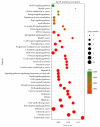A Network Pharmacology Approach to Uncover the Multiple Mechanisms of Hedyotis diffusa Willd. on Colorectal Cancer
- PMID: 29619072
- PMCID: PMC5829364
- DOI: 10.1155/2018/6517034
A Network Pharmacology Approach to Uncover the Multiple Mechanisms of Hedyotis diffusa Willd. on Colorectal Cancer
Abstract
Background: As one of the most frequently diagnosed cancer diseases globally, colorectal cancer (CRC) remains an important cause of cancer-related death. Although the traditional Chinese herb Hedyotis diffusa Willd. (HDW) has been proven to be effective for treating CRC in clinical practice, its definite mechanisms have not been completely deciphered.
Objective: The aim of our research is to systematically explore the multiple mechanisms of HDW on CRC.
Methods: This study adopted the network pharmacology approach, which was mainly composed of active component gathering, target prediction, CRC gene collection, network analysis, and gene enrichment analysis.
Results: The network analysis showed that 10 targets might be the therapeutic targets of HDW on CRC, namely, HRAS, PIK3CA, KRAS, TP53, APC, BRAF, GSK3B, CDK2, AKT1, and RAF1. The gene enrichment analysis implied that HDW probably benefits patients with CRC by modulating pathways related to cancers, infectious diseases, endocrine system, immune system, nervous system, signal transduction, cellular community, and cell motility.
Conclusions: This study partially verified and predicted the pharmacological and molecular mechanism of HDW against CRC from a holistic perspective, which will also lay a foundation for the further experimental research and clinical rational application of HDW.
Figures





Similar articles
-
Network Pharmacology-Based Approach to Investigate the Mechanisms of Hedyotis diffusa Willd. in the Treatment of Gastric Cancer.Evid Based Complement Alternat Med. 2018 May 2;2018:7802639. doi: 10.1155/2018/7802639. eCollection 2018. Evid Based Complement Alternat Med. 2018. PMID: 29853970 Free PMC article.
-
Network pharmacology and experimental validation to identify the potential mechanism of Hedyotis diffusa Willd against rheumatoid arthritis.Sci Rep. 2023 Jan 25;13(1):1425. doi: 10.1038/s41598-022-25579-3. Sci Rep. 2023. PMID: 36697436 Free PMC article.
-
Investigating the Multi-Target Pharmacological Mechanism of Hedyotis diffusa Willd Acting on Prostate Cancer: A Network Pharmacology Approach.Biomolecules. 2019 Oct 9;9(10):591. doi: 10.3390/biom9100591. Biomolecules. 2019. PMID: 31600936 Free PMC article.
-
Molecular Mechanism of Anti-Colorectal Cancer Effect of Hedyotis diffusa Willd and Its Extracts.Front Pharmacol. 2022 Jun 2;13:820474. doi: 10.3389/fphar.2022.820474. eCollection 2022. Front Pharmacol. 2022. PMID: 35721163 Free PMC article. Review.
-
Antitumor potential of Hedyotis diffusa Willd: A systematic review of bioactive constituents and underlying molecular mechanisms.Biomed Pharmacother. 2020 Oct;130:110735. doi: 10.1016/j.biopha.2020.110735. Epub 2020 Sep 12. Biomed Pharmacother. 2020. PMID: 34321173
Cited by
-
Network pharmacology and RNA sequencing studies on triterpenoid saponins from Bupleurum chinense for the treatment of breast cancer.RSC Adv. 2019 Dec 12;9(70):41088-41098. doi: 10.1039/c9ra08970e. eCollection 2019 Dec 9. RSC Adv. 2019. PMID: 35540038 Free PMC article.
-
Analyzing the multi-target pharmacological mechanism of folium Artemisia argyi acting on breast cancer: a network pharmacology approach.Ann Transl Med. 2022 Dec;10(24):1368. doi: 10.21037/atm-22-5769. Ann Transl Med. 2022. PMID: 36660662 Free PMC article.
-
A Network Pharmacology to Explore the Mechanism of Calculus Bovis in the Treatment of Ischemic Stroke.Biomed Res Int. 2021 Mar 10;2021:6611018. doi: 10.1155/2021/6611018. eCollection 2021. Biomed Res Int. 2021. Retraction in: Biomed Res Int. 2024 Mar 20;2024:9768532. doi: 10.1155/2024/9768532. PMID: 33778069 Free PMC article. Retracted.
-
Network pharmacology-based study of the mechanisms of action of anti-diabetic triterpenoids from Cyclocarya paliurus.RSC Adv. 2020 Oct 7;10(61):37168-37181. doi: 10.1039/d0ra06846b. eCollection 2020 Oct 7. RSC Adv. 2020. PMID: 35521232 Free PMC article.
-
Network Pharmacology Integrated Molecular Docking Reveals the Antiosteosarcoma Mechanism of Biochanin A.Evid Based Complement Alternat Med. 2019 Jan 6;2019:1410495. doi: 10.1155/2019/1410495. eCollection 2019. Evid Based Complement Alternat Med. 2019. PMID: 30723510 Free PMC article.
References
LinkOut - more resources
Full Text Sources
Other Literature Sources
Research Materials
Miscellaneous

